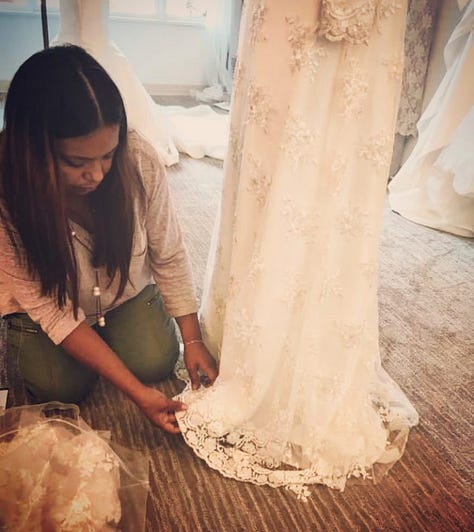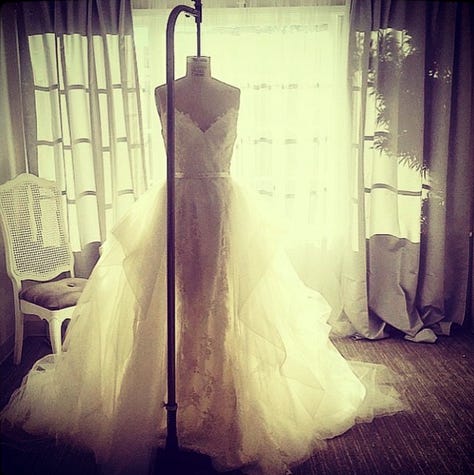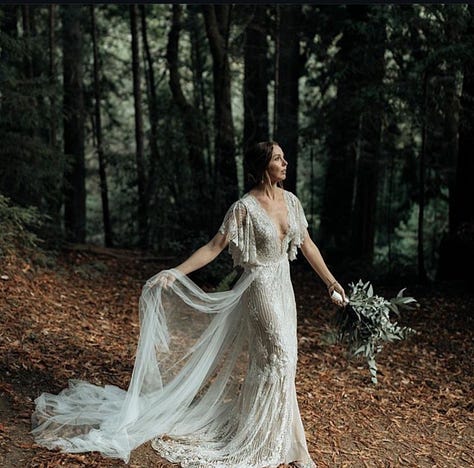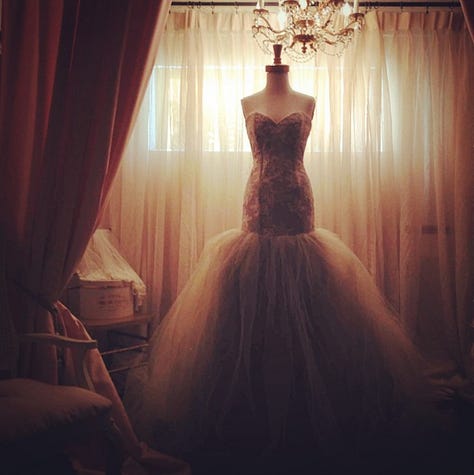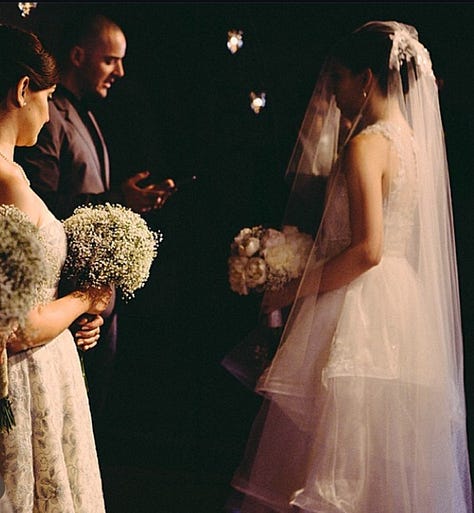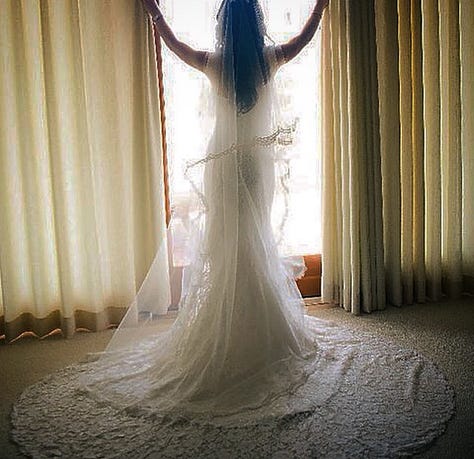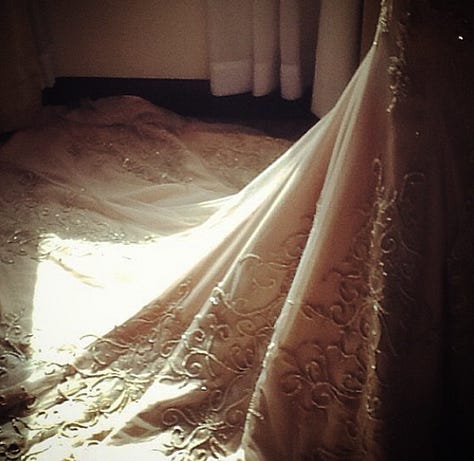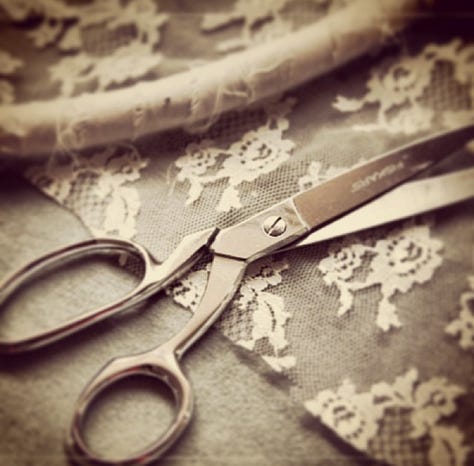06.14.25 Los Angeles 6:29 a.m.
There’s a stillness I’ve learned to live with. Not a stillness born of calm, but one that settles into the body- in joints that ache before the rain, in limbs that feel like strangers, in the strange silence that follows the last slammed door of a once-shared home.
It is in this stillness that I have learned to create again, as a woman with Multiple Sclerosis, as a mother whose children have grown beyond the soft dependencies of childhood, and as an artist searching for a new shape for her voice.
There was a time when my life unfolded in bolts of silk and lace. Inside the atelier I built with my own hands- I cut and shaped dresses that would carry other women into new lives. I was a self-taught dressmaker then, and for over a decade and a half, wedding gowns were the language I spoke most fluently.
I conjured silk and satin into symbols. I cut and stitched the fabric of women's dreams- each gown a promise of arrival, of love, of futures so bright they required veils to soften the glare.
There was intimacy in those fittings, joy in the transformation, and sometimes a quiet ache, too. Because I understood something unspoken in each woman’s body and posture- the way we all hope, and the way we sometimes brace for what never arrives.
I was good at it- very good. Until the day came when I could no longer steady my hands, when the fine motor control that once defined my craftsmanship began to falter.
The bridal gown is a strange kind of artifact. It is both a garment and a prophecy- a silhouette of what is hoped for, stitched together in secret consultations and late-night revisions. I became fluent in the quiet aspirations of women in love. I took their measurements; I listened to their doubts; I adjusted for movement and gravity and fear.
As I write this now, Saturday morning, in the quiet of a house that no longer echoes with the small noise of childhood- no lunchboxes to pack, no school lines to beat- I am no longer a dressmaker. I am a writer. I am a woman in her fifties, living with Multiple Sclerosis. I am divorced. And yet, strangely, I am not diminished. If anything, I have entered a different kind of atelier- one that resides inside the body itself, and inside the solitude it keeps, threading memory into language. Hemming the frayed edges of grief, womanhood, illness, survival. Trying to make beauty where there is rupture.
Frida Kahlo said she painted herself because she was the subject she knew best, and because she was often “alone.” I understand this. MS has made my body both familiar and foreign terrain. Divorce has taught me what it means to vanish from a shared narrative and begin again, untethered. And motherhood- especially as it shifts from necessity to nostalgia- has humbled me into silence more times than I can count. I return to Kahlo now as a point of reference, not just because of her disability, but because of her defiance. Pain never silenced her. It sharpened her.
The poet, art critic, novelist and painter, John Berger wrote, “The sharing of pain is one of the essential preconditions for a refinding of dignity and hope.” I return to that line often. It reminds me that expression- whether through fabric, or words, or silence made visible- is not simply a means of survival. It’s a way back to ourselves. A way to dignify what we’ve endured by refusing to carry it alone.
In that spirit, I want to share. Not for pity, but for connection. Because this journey- this reinvention as an artist, a writer, a mother no longer needed in quite the same ways- disabled, is not just about loss. It’s also about return.
And so it is, in a way, this return. I write not despite the pain, but alongside it. With it. In many ways, it is the pain that has made the writing necessary.
My current work is a book about Elizabeth Keckley- formerly enslaved, she became a successful dressmaker in Washington, D.C., best known as the modiste and confidante of Mary Todd Lincoln. Keckley purchased her own freedom through her needlework. She fashioned garments for women who shaped a nation, while remaining mostly invisible in the historical record. And yet, she wrote a memoir that asserted her place not only as America’s first true couturière, but as a revolutionary whose work extended far beyond the fitting room. She was a freedom fighter, an abolitionist, and a woman who refused to let circumstance or history, stand in the way of liberation.
I find myself drawn to her- perhaps because I, too, have lived much of my life behind the seams. Her life was one of reinvention. Like Keckley, I know what it means to reinvent oneself not just once, but over and over. She knew solitude and the discipline it demands. She knew that to sew for others while mending your own wounds is a form of resistance- a kind of radical defiance. She knew that to make something beautiful out of pain is to insist on authorship of your own story.
When I left my marriage, I also left behind a version of myself- the version who had become fluent in the art of accommodation. Around the same time, just as my work as a designer and couturière was reaching its height, I learned of my diagnosis. What I understand now, in hindsight, is that something larger was taking shape. It was as if my body had grown weary of its own silence, as if it could no longer contain what I had spent years holding in.
Yet there is a particular loneliness that accompanies chronic illness- not just the isolation it enforces, but the way it distorts the very texture of time. Days stretch and blur. Mornings arrive without urgency. In their slowness, I have found space- not only to rest, but to listen. To write. And to remember.
I no longer measure women for gowns. I measure memory. I cut shapes from silence. The solitude I once feared has become, strangely, my co-creator.
So here I am. No longer behind the sewing machine, but still creating. No longer packing lunchboxes or rushing to the school pickup line, but still a mother. No longer someone’s wife, but still a woman. A woman who lives with illness, yes. But also a woman who writes, who remembers, who dreams, who creates. Who refuses to be invisible.
In the end, it may not be so different from dressmaking. There is a body. There is a wound. There is the attempt to clothe it in something that holds.
This is my atelier now: a quiet house, a blank page, the hum of something still becoming.
Click here for my book “LIZZY: The Elizabeth Keckley Story, from bondage to becoming America's first couturière”
